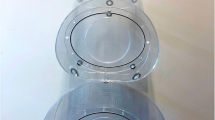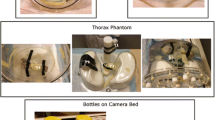Abstract
We developed a phantom for single-photon emission computed tomography (SPECT), with the objective of assessing image quality to optimize administered dose and acquisition time. We investigated whether the concept of counts-per-volume (CPV), which is used as a predictor of visual image quality in positron emission tomography, can be used to estimate the acquisition time required for each SPECT image. QIRE phantoms for the head (QIRE-h) and torso (QIRE-t) were developed to measure four physical indicators of image quality in a single scan: uniformity, contrast of both hot and defective lesions with respect to the background, and linearity between radioactivity concentration and count density. The target organ’s CPV (TCPV), sharpness index (SI), and contrast-to-noise ratio (CNR) were measured for QIRE-h and QIRE-t phantoms, and for anthropomorphic brain and torso phantoms. The SPECT image quality of the four phantoms was visually assessed on a 5-point scale. The acquisition time and TCPV were correlated for all four phantoms. The SI and CNR values were nearly identical for the QIRE and anthropomorphic phantoms with comparable TCPV. The agreement between the visual scores of QIRE-h and brain phantoms, as well as QIRE-t and torso phantoms, was moderate and substantial, respectively. Comparison of SPECT image quality between QIRE and anthropomorphic phantoms revealed close agreement in terms of physical indicators and visual assessments. Therefore, the TCPV concept can also be applied to SPECT images of QIRE phantoms, and optimization of imaging parameters for nuclear medicine examinations may be possible using QIRE phantoms alone.






Similar content being viewed by others
References
Exposure JNfRaIoM. National Diagnostic Reference Levels in Japan (2020). 2020.
Peters SMB, van der Werf NR, Segbers M, van Velden FHP, Wierts R, Blokland K, et al. Towards standardization of absolute SPECT/CT quantification: a multi-center and multi-vendor phantom study. EJNMMI Phys. 2019;6(1):29.
Okuda K, Nakajima K, Yamada M, Wakabayashi H, Ichikawa H, Arai H, et al. Optimization of iterative reconstruction parameters with attenuation correction, scatter correction and resolution recovery in myocardial perfusion SPECT/CT. Ann Nucl Med. 2014;28(1):60–8.
Zhang R, Wang M, Zhou Y, Wang S, Shen Y, Li N, et al. Impacts of acquisition and reconstruction parameters on the absolute technetium quantification of the cadmium-zinc-telluride-based SPECT/CT system: a phantom study. EJNMMI Phys. 2021;8(1):66.
Caobelli F, Kaiser SR, Thackeray JT, Bengel FM, Chieregato M, Soffientini A, et al. IQ SPECT allows a significant reduction in administered dose and acquisition time for myocardial perfusion imaging: evidence from a phantom study. J Nucl Med. 2014;55(12):2064–70.
Alqahtani MM, Willowson KP, Constable C, Fulton R, Kench PL. Optimization of 99mTc whole-body SPECT/CT image quality: A phantom study. J Appl Clin Med Phys. 2022;23(4):e13528.
Sugiura A, Onoguchi M, Shibutani T, Kouno Y. Influence of minimum counts in brain perfusion SPECT: phantom and clinical studies. J Nucl Med Technol. 2022;50:342–7.
Mizuta T, Senda M, Okamura T, Kitamura K, Inaoka Y, Takahashi M, et al. NEC density and liver ROI S/N ratio for image quality control of whole-body FDG-PET scans: comparison with visual assessment. Mol Imaging Biol. 2009;11(6):480–6.
Ichikawa H, Kawakami K, Onoguchi M, Shibutani T, Nagatake K, Hosoya T, et al. Automatic quantification package (Hone Graph) for phantom-based image quality assessment in bone SPECT: computerized automatic classification of detectability. Ann Nucl Med. 2021;35(8):937–46.
Mizutani A, Matsunari I, Kobayashi M, Nishi K, Fujita W, Miyazaki Y, et al. Impact of injection dose, post-reconstruction filtering, and collimator choice on image quality of myocardial perfusion SPECT using cadmium-zinc telluride detectors in the rat. EJNMMI Phys. 2015;2(1):7.
Shiiba T, Sekikawa Y, Tateoka S, Shinohara N, Inoue Y, Kuroiwa Y, et al. Verification of the effect of acquisition time for SwiftScan on quantitative bone single-photon emission computed tomography using an anthropomorphic phantom. EJNMMI Phys. 2022;9(1):48.
Ogawa K. Image distortion and correction in single photon emission CT. Ann Nucl Med. 2004;18(3):171–85.
He B, Frey EC. Effects of shortened acquisition time on accuracy and precision of quantitative estimates of organ activity. Med Phys. 2010;37(4):1807–15.
Bar R, Przewloka K, Karry R, Frenkel A, Golz A, Keidar Z. Half-time SPECT acquisition with resolution recovery for Tc-MIBI SPECT imaging in the assessment of hyperparathyroidism. Mol Imaging Biol. 2012;14(5):647–51.
Salkica N, Begic A, Zubovic S, Ceric S, Basic A, Sehic A, et al. Impact of reduced acquisition time on bone single-photon emission computed tomography images in oncology patients. Acta Inform Med. 2022;30(1):36–40.
Ichikawa H, Miyaji N, Onoguchi M, Shibutani T, Nagaki A, Kato T, et al. Feasibility of ultra-high-speed acquisition in xSPECT bone algorithm: a phantom study with advanced bone SPECT-specific phantom. Ann Nucl Med. 2022;36(2):183–90.
Fukukita H, Suzuki K, Matsumoto K, Terauchi T, Daisaki H, Ikari Y, et al. Japanese guideline for the oncology FDG-PET/CT data acquisition protocol: synopsis of Version 2.0. Ann Nucl Med. 2014;28(7):693–705.
Acknowledgements
The authors thank Koutatsu Tsuboi, Yoshinao Misu, and Akie Sugiura for their cooperation in the visual assessments.
Funding
This study was supported by Japanese Society of Radiological Technology Research Grants (2020 and 2021).
Author information
Authors and Affiliations
Corresponding author
Ethics declarations
Conflict of interest
The authors have no conflicts of interest to disclose.
Ethical approval
All procedures involving human participants performed in this study were in accordance with the ethical standards of the Institutional Review Board (IRB) and with the 1964 Helsinki Declaration and its later amendments or comparable ethical standards.
Human/animal rights
This article does not contain any studies performed with animals.
Additional information
Publisher's Note
Springer Nature remains neutral with regard to jurisdictional claims in published maps and institutional affiliations.
About this article
Cite this article
Ichikawa, H., Shibutani, T., Shimada, H. et al. Feasibility of using counts-per-volume approach with a new SPECT phantom to optimize the relationship between administered dose and acquisition time. Radiol Phys Technol 16, 244–253 (2023). https://doi.org/10.1007/s12194-023-00713-6
Received:
Revised:
Accepted:
Published:
Issue Date:
DOI: https://doi.org/10.1007/s12194-023-00713-6




